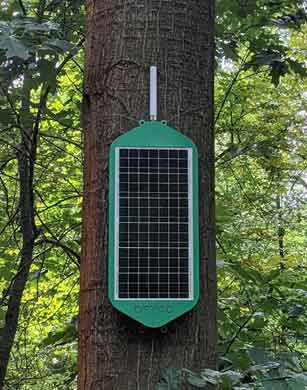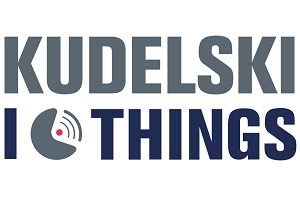Germany, 1 March 2023 – Dryad Networks has collaborated with Vodafone to bring its wireless environmental sensor network to Spain, supporting the ‘ultra-early’ detection of wildfires across the country. The system can operate in forest environments where the impacts of climate change are more difficult to monitor and could reduce the percentage of area devastated by fire, which, according to the European Forest Fire Information System (EFFIS), rose in Spain to almost 310,000 hectares in the last year.
Dryad has developed a wireless network of environmental, solar-powered gas sensors that is based on the open standard for long-range IoT networks. Its distributed architecture enables large-scale deployment in areas without network coverage, and the data collected on the network is processed by machine learning tools embedded within the sensor and cloud-based data tools for analysis, monitoring and alerting.
As a world provider of IoT technology, Vodafone will provide the communications infrastructure to support Dryad’s wireless network of sensors, Silvanet. The security services company, meanwhile, will be responsible for installing and maintaining the sensors and monitoring them from its operations centre. The pioneering solution was presented at this year’s MWC 2023 in Barcelona.


The collaboration will enable an immediate response to fire incidents with wildfires detected within minutes and alerts sent directly to the appropriate firefighting resource. The system will be based on an IoT deployment using 3 types of elements:
- Solar-powered gas sensors, which are installed in trees and can detect a fire during the smouldering stage.
- Mesh gateways with broad-spectrum modulation technology, to give “coverage” to gas sensors and aggregate data from deployed sensors.
- Monitoring and communications systems with connectivity, which collate the information collected and send it to the cloud that manages the monitoring system.
Silvanet adapts to any type of forest environment, which is essential for the market as Spain’s forest ecosystems occupy over twenty-six million hectares, of which almost fifteen million are wooded (representing 29% of the national territory). It does this by using artificial intelligence embedded in the gas sensors to learn and identify the different ‘smells’ of a forest. This enables the sensors to detect a fire in its early smouldering stages when the fire is still easy to put out. The system can also operate in wooded areas without network coverage.
As a result, the partnership between Dryad and Vodafone enables large-scale deployment of this technology across Spain’s forested areas to complement camera and satellite-based detection systems. This could drastically reduce wildfire detection times and make tackling fires in the country easier.


To further test the application of this solution, the security services company will soon complete the first pilot in Spain, carried out with one of its large industrial customers. The aim is to incorporate the solution into its portfolio of services quickly for other private clients as well as for public administrations.
“We are very pleased to be working with Vodafone to bring our wildfire detection technology to Spain, a country that suffers greatly from forest fires,” says Carsten Brinkschulte, CEO and Co-founder of Dryad. “Our Silvanet solution represents a breakthrough in wildfire detection due to its ability to detect fires within minutes, and we look forward to further deployments in the region.”
“Our cloud-based IoT solutions are world leaders for their detection and communication capabilities, and help optimise the cost of firefighting, minimising wildfires’ impact on forest areas and helping to protect thousands of lives and preserve natural ecosystems,” says Daniel Barallat, director of IoT at Vodafone Spain.
Comment on this article below or via Twitter: @IoTNow_OR @jcIoTnow
- SEO Powered Content & PR Distribution. Get Amplified Today.
- Platoblockchain. Web3 Metaverse Intelligence. Knowledge Amplified. Access Here.
- Source: https://www.iot-now.com/2023/03/01/128307-dryad-vodafone-to-bring-ultra-early-wildfire-detection-technology-to-spanish-market/
- 000
- 1
- 2023
- a
- ability
- According
- across
- adapts
- Administrations
- analysis
- and
- Application
- appropriate
- architecture
- AREA
- areas
- article
- artificial
- artificial intelligence
- barcelona
- based
- below
- between
- breakthrough
- bring
- camera
- capabilities
- centre
- ceo
- change
- clients
- Climate
- Climate change
- Cloud
- Co-founder
- collaborated
- collaboration
- Communication
- Communications
- company
- Complement
- complete
- Connectivity
- Cost
- could
- country
- coverage
- Customers
- Daniel
- data
- deployed
- deployment
- deployments
- detected
- Detection
- developed
- different
- difficult
- directly
- Director
- distributed
- drastically
- during
- Early
- easier
- Ecosystems
- elements
- embedded
- enable
- enables
- Environment
- environmental
- environments
- essential
- European
- Fire
- fires
- First
- forest
- Forward
- from
- further
- GAS
- Give
- greatly
- help
- helping
- HTTPS
- identify
- immediate
- Impact
- Impacts
- in
- incorporate
- industrial
- information
- Infrastructure
- installed
- installing
- Intelligence
- iot
- IT
- large
- large-scale
- Last
- Last Year
- leaders
- LEARN
- learning
- Lives
- Look
- machine
- machine learning
- make
- manages
- March
- Market
- max-width
- Meanwhile
- million
- minutes
- Monitor
- monitoring
- more
- National
- Natural
- network
- networks
- ONE
- open
- operate
- Operations
- optimise
- Other
- Partnership
- percentage
- pilot
- Pioneering
- plato
- Plato Data Intelligence
- PlatoData
- pleased
- portfolio
- presented
- private
- protect
- provide
- provider
- public
- put
- quickly
- reduce
- region
- representing
- represents
- resource
- response
- responsible
- result
- ROSE
- says
- security
- sensors
- Services
- solar-powered
- solution
- Solutions
- Soon
- Spain
- Spanish
- Stage
- stages
- standard
- Still
- Suffers
- support
- Supporting
- system
- Systems
- Technology
- test
- The
- the information
- their
- thousands
- times
- to
- tools
- Trees
- types
- vodafone
- which
- will
- wireless
- within
- without
- working
- world
- year
- zephyrnet












